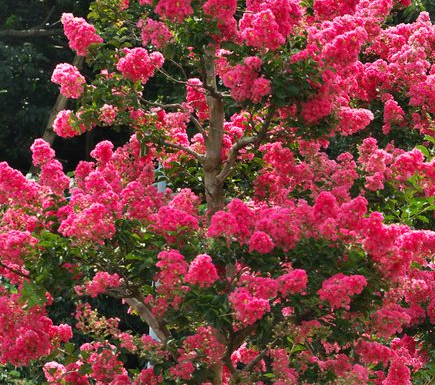Crape myrtle or Lagerstroemia is a genus of approximately 50 species of evergreen and deciduous shrubs and trees native to the Indian subcontinent, Northern Australia, Southeast Asia or other parts of Oceania. This species is cultivated in warmer climates all over the globe. These beautiful flowering plants serve both commercially and privately for ornamental purposes.
Tuskegee crape myrtle is also known for its exceptional heat tolerance and cold hardiness and is covered; in vibrant deep pink-red blooms during summers. The growth rate of a Tuskegee myrtle shrub is considerably high. If provided with the ideal conditions, it can survive for 50 years or more. Tuskegee crape myrtle is a relatively low maintenance tree; the pruning is done best in late winter after the threat of severe cold passes. With no negative characteristics associated, it serves in landscape applications such as mass planting, screening or hedges, general garden use and accent.
Size
Tuskegee crape myrtle is a dense and multi-stemmed tree with a rounded form. The characteristic fine texture of crape myrtle sets it apart from various other landscape plants that have less refined foliage. The plant is highly tolerant of urban pollution.
This ornamental shrub usually grows with a spread of 20 feet with a low canopy. It has a classic clearance of around 3 feet above ground level and is suitable for plantations under power lines. It is bathed in elegant panicles of frilly hot pink coloured flowers accompanied by red overtones at the ends of the branches during early fall and early summer. The shrub consists of attractive dark green deciduous foliage emerging red in spring. The oval leaves of this tree are also of crucial significance as they are highly ornamental and turn red in fall. The mottled tanbark of a Tuskegee crape myrtle adds significant winter interest and is showy.
Height
Tuskegee crape myrtle can easily grow up to 20 feet in height with maturity with a spread of approximately 20 feet. Plants usually tend to defoliate in extreme drought conditions however new foliage and flowers emerge typically during the return of the summer rains. Flowers on these trees appear for around 100 days most of the year.
Several crape myrtles function as magnets for a host-specific aphid that can infest only crape myrtle and not other plants. The damage done is not lethal to any of the crape myrtles. Many beneficial insects that feed on pests damaging other landscape plants use this aphid for eating purposes. In this manner, the crape myrtle aphid can serve as prey for beneficial insects. For this reason, planting crape myrtle trees that can attract aphids increases the probability of control of insect pests on other plants in the landscape from a biological point of view.
Problems
The main problem associated with a myrtle tree is pruning. If heavily pruned, it will cause the myrtle tree to put its energy into growing limbs and new leaves. During plantation, remain careful not to plant it too deep into the soil. While planting the Tuskegee crepe myrtle tree, it is essential to level the top of the root to level with the soil to make it easy for the root ball to gather oxygen. The plant cannot grow when oxygen is insufficient and usually starts declining in such a scenario. Lack of water during dry conditions is also an important factor causing complications. The crape myrtle tree must have a sufficient amount of water. The mulching step aids the crape myrtle tree to maintain the soil with enough moisture during the drought span.
Care
The Tuskegee crape myrtle tree does best in partial to the full sunshade. It grows preferably well in average to moist conditions and should never be allowed to dry out. For its care, it is interesting to mention that the myrtle tree is very fussy regarding its soil conditions and thus requires acidic and rich soils to ensure success. If the above mentioned conditions are not available, the tree is subject to yellowing or chlorosis of the foliage in alkaline soils. Being highly tolerant of urban pollution, it can thrive in inner-city environments also. This variety of myrtle is an interspecific one. Homeowners of the Southwestern region appreciate the water wisdom of the crape myrtles. For their care, low to moderate watering is needed. Always plant a crape myrtle tree in a spot with sun exposure. Their tolerance of the urban environment helps them serve by adding natural colors to the urban gardens.



